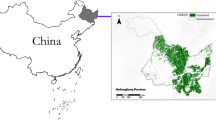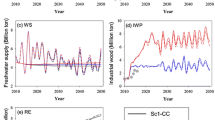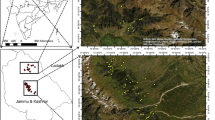Abstract
The Natural Forest Protection Program (NFPP) is one of the key ecological forestry programs in China. It not only facilitates the improvement of forest ecological quality in NFPP areas, but also plays a significant role in increasing the carbon storage of forest ecosystems. The program covers 17 provinces, autonomous regions, and municipalities with correspondingly diverse forest resources and environments, ecological features, engineering measures and forest management regimes, all of which affect regional carbon storage. In this study, volume of timber harvest, tending area, pest-infested forest, fire-damaged forest, reforestation, and average annual precipitation, and temperature were evaluated as factors that influence carbon storage. We developed a vector autoregression model for these seven indicators and we studied the dominant factors of carbon storage in the areas covered by NFPP. Timber harvest was the dominant factor influencing carbon storage in the Yellow and Yangtze River basins. Reforestation contributed most to carbon storage in the state-owned forest region in Xinjiang. In state-owned forest regions of Heilongjiang and Jilin Provinces, the dominant factors were forest fires and forest cultivation, respectively. For the enhancement of carbon sequestration capacity, a longer rotation period and a smaller timber harvest are recommended for the Yellow and Yangtze River basins. Trees should be planted in state-owned forests in Xinjiang. Forest fires should be prevented in state-owned forests in Heilongjiang, and greater forest tending efforts should be made in the state-owned forests in Jilin.





Similar content being viewed by others
References
Cai LX (2014) Forest protection program in Xinjiang and state forest management reform. For Econ 36(2):61–67 (in Chinese with english abstract)
Cao SX, Wang XQ, Song YZ, Chen L, Feng Q (2010) Impacts of the Natural Forest Conservation Program on the livelihoods of residents of Northwestern China: perceptions of residents affected by the program. Ecol Econ 69(7):1454–1462
Chen YL, Luo GP, Ye H, Zhao SB, Wang YG, Han QF (2011) Sources and sinks of carbon from forest land use change in Xinjiang, China during 1975–2005. Geograph Res 32(11):1987–1999
Cheng Y (2009) A study on factors affect China’s price fluctuation in open economy. Xiamen University, Xiamen, pp 31–32 (in Chinese with English Abstract)
China Forestry Statistics Yearbook (1977–2013). China Forestry Press, Beijing
Chinese Ministry of Forestry (1982, 1989, 1994, 1999, 2004, 2009, 2014) Forest Resource Statistics of China (1977–1981, 1984–1988, 1989–1993, 1994–1998, 1999–2003, 2004–2008, 2009–2013). Department of Forest Resource and Management, Chinese Ministry of Forestry, Beijing, China
Cui HR, Wang D (2010) A study of China’s energy-economy-environment system based on VAR model. J Beijing Inst Technol (Social Science Edition) 12(1):23–28
Edstrom F, Nilsson H, Stage J (2012) The Natural Forest Protection Program in China: a contingent valuation study in Heilongjiang province. J Environ Sci Eng B 1(3):426–432
Fang JY, Chen AP, Peng CH, Zhao SQ, Ci LJ (2001) Changes in forest biomass carbon storage in China between 1949 and 1998. Science 291(5525):2320–2322
Fang JY, Guo ZD, Piao SL, Chen AP (2007) Terrestrial vegetation carbon sinks in China, 1981-2000. Sci China Earth Sci 50(9):1341–1350
Gao TM (2006) Econometric analysis and modeling-application and example of Eviews. Tsinghua University Press, Beijing, pp 164–205 (In Chinese)
Guo ZD, Hu HF, Li P, Li NY, Fang JY (2013) Spatio-temporal changes in biomass carbon sinks in China’s forests from 1977 to 2008. Sci China Life Sci 56(7):661–671
Horst W, Andreas W, Fredrich K (2005) Local impacts and responses to regional forest conservation and rehabilitation programs in China’s northwest Yunnan province. Agric Syst 85(3):234–253
Hu HF, Liu GH (2006) Carbon sequestration of China’s National Natural Forest Protection Project. Acta Ecol Sin 26(1):291–296 (in Chinese with English Abstract)
Li S (2012) Study on the forest carbon sink capacity of state-owned forestry industry regions in Jilin province. Northeast Forestry University (in Chinese with English Abstract)
Liu H, Wang XF, Chen SJ, Huo P (2005) Dynamic analysis and evaluation of Xinjiang forest resources: based on RS and GIS. J Geog Sci 15(3):346–352
Liu JG, Li SX, Ouyang ZY, Tam C, Chen XD (2008) Ecological and socioeconomic effects of China’s policies for ecosystem services. PNAS 105(28):9477–9482
Luo J, Zhou GH, Lai JM, Hu TX, Zhao AJ, Huang CD (2010) Application of remote sensing technique to monitoring the natural forest resources in western Sichuan. J Sichuan Agric Univ 28(3):313–318 (in Chinese with English Abstract)
Ren GP, Young SS, Wang L, Wang W, Long YC, Wu RD, Li JS, Zhu JG, Yu DW (2015) Effectiveness of China’s national forest protection program and nature reserves. Conserv Biol 29(5):1368–1377
Shi L (2011) Dynamic change of forests in Xinjiang in recent 25 Years. Arid Zone Res 28(1):17–24 (in Chinese with English Abstract)
Wang XK, Feng ZW, Zhuang YH (2001) CO2, CO and CH4 emission from forest fires in China. Scientia Silvae Sinicae 37(1):90–95 (in Chinese with English Abstract)
Wang XC, Qi G, Yu DP, Zhou L, Dai LM (2011) Carbon storage, density, and distribution in forest ecosystems in Jilin province of northeast China. Chin J Appl Ecol 22(8):2013–2020 (in Chinese with English Abstract)
Wei YW, Dai LM, Fang XM, Zhao W (2013) Estimating forest ecosystem carbon storage under the Natural Forest Protection Program in Northeast China. Paper presented at: 2nd International Conference on Energy and Environmental Protection (ICEEP 2013), Guilin, Peoplesr China
Wu RD, Zhang S, Yu DW, Zhao P, Li XH, Wang LZ, Yu Q, Ma J, Chen A, Long YC (2011) Effectiveness of China’s nature reserves in representing ecological diversity. Front Ecol Environ 9(7):383–389
Wu SN, Li YQ, Yu DP, Zhou L, Zhou WM, Guo Y, Wang XY, Dai LM (2015) Analysis of factors that influence forest vegetation carbon storage by using the VAR model: a case study in Shaanxi Province. Acta Ecol Sin 35(1):196–203 (in Chinese with English Abstract)
Xie Y, Zhang JC (2002) Forest protecting from a viewpoint of soil and water loss actuality of Huanghe River and Changjiang River Valley. J Nanjing For Univ 26(6):88–92 (in Chinese with English Abstract)
Xu HC (1998) Daxinanling forest in China. Science Press, Beijing, pp 184–220 (In Chinese)
Xu SS (2011) Research on forest carbon sequestration in China: a case study of forest industrial state-owned region in Heilongjiang Province. Economic Science Press, Beijing, pp 112–140 (In Chinese)
Yu DY, Shi PJ, Han GY, Zhu WQ, Du SQ, Xun B (2011) Forest ecosystem restoration due to a national conservation plan in China. Ecol Eng 37(9):1387–1397
Zhang YQ (2012) On the identification issues of the structural VAR models: a review. J Appl Stat Manag 31(5):805–812 (in Chinese with English Abstract)
Zhang PC, Shao GF, Zhao G, LeMaster DC, Parker GR, Dunning JB, Li QL (2000) China’s forest policy for the 21st century. Science 288(5474):2135–2136
Zhang K, Hori Y, Zhou SZ, Michinaka T, Hirano Y, Tachibana S (2011) Impact of Natural Forest Protection Program policies on forests in northeastern China. For Stud China 13(3):231–238
Zhou WM, Lewis BJ, Wu SN, Yu DP, Zhou L, Wei YW, Dai LM (2014) Biomass carbon storage and its sequestration potential of afforestation under Natural Forest Protection Program in China. Chin Geogr Sci 24(4):406–413
Zhu HM, Han YQ, Zheng JC (2005) Bayesian ARP models for forecasting based on Normal-Gamma conjugate prior distribution. Stat Dec 2:8–9 (in Chinese with English Abstract)
Author information
Authors and Affiliations
Corresponding author
Additional information
Project funding: This study was funded by Special Research Project of Institute of Applied Ecology, CAS (No. Y5YZX151YD) and Key Laboratory of Forest Ecology and Management, Institute of Applied Ecology, CAS (No. LFEM2016-05).
The online version is available at http://www.springerlink.com
Corresponding editor: Hu Yanbo.
Rights and permissions
About this article
Cite this article
Wu, S., Li, J., Zhou, W. et al. A statistical analysis of spatiotemporal variations and determinant factors of forest carbon storage under China’s Natural Forest Protection Program. J. For. Res. 29, 415–424 (2018). https://doi.org/10.1007/s11676-017-0462-z
Received:
Accepted:
Published:
Issue Date:
DOI: https://doi.org/10.1007/s11676-017-0462-z




